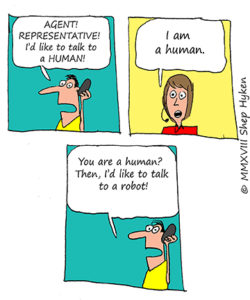 Technology is great… until it’s not. You are on a website. A little box pops up and there’s a picture of a customer service rep with a typed message asking if you need help. So, you type a question, and just a moment later you get a response. That’s the perfect scenario. But, what happens when the response is wrong? I was on a website looking for a camera for my notebook computer. The chat box popped up, asking if I needed help. I typed in a question about the camera and the response was about what computer I was interested in purchasing. I had no interest in buying a computer. The digital experience had gone awry.
Technology is great… until it’s not. You are on a website. A little box pops up and there’s a picture of a customer service rep with a typed message asking if you need help. So, you type a question, and just a moment later you get a response. That’s the perfect scenario. But, what happens when the response is wrong? I was on a website looking for a camera for my notebook computer. The chat box popped up, asking if I needed help. I typed in a question about the camera and the response was about what computer I was interested in purchasing. I had no interest in buying a computer. The digital experience had gone awry.
There needs to be a balance between the digital and human experience. A total digital experience is not always possible. If a customer needs support, a chatbot may not have all the answers. The best chatbots have been programmed to understand when it doesn’t have an answer or the customer is confused. At that point, the chatbot moves the customer from the digital experience to a human experience, as it seamlessly switches you to a human to continue the conversation. That’s the way it should work – just at the right point, moving to the human experience. That’s balance.
There are other forms of digital experiences. Zappos is the online retailer that makes it easy to connect with a customer service rep. They know customers will have questions, and even though they are an online company that sells off their website, they make it super-easy to connect with a human.
And, sometimes the experience moves from human to digital. For example, I may call to talk to a support rep. Maybe I have a “how do I do this” type of question. The customer support rep can simply tell me and walk me through the steps, and that may take some time. So, maybe a better option is to send me an email with explicit instructions. Or, maybe send me a link to a video that shows me, step-by-step, how to accomplish what I’m having trouble with.
So, how does a company strike a balance between digital and human? The answer is knowing where to cross over between digital and human – or the other way around. And, that point of the crossover is when there is friction. At the point of friction is the right place to switch. In the examples I just provided, there was a point of friction. The chatbot knew when to flip me over to a live agent. The customer support rep knew I would have a better experience watching a video tutorial. Once you know the point of friction, you can strike the balance between the digital experience and the human experience, giving your customers the experience they deserve.




Hi Shep: the distinction you have made between digital and human experience is an internal view. That’s the problem. I don’t think we need to balance anything. Rather, we need effective design.
From the customer’s point of view, everything is human experience. If marketers would look at things the same way, maybe digital technologies would be deployed in ways that are more customer-friendly, useful, and compassionate.
Hi Andrew – I like the way you think. I agree it is all part of the design. The goal is to create the BEST experience, human or digital, but we all have to think human first because the customer is human!
Andy, calling everything a human experience because customers are humans doesn’t help us understand the design challenge. Which is: how should experiences be designed to deliver the right benefits to customers and businesses alike, using a combination of human and tech resources.
Some interactions are clearly better off done without human intervention (ATM cash withdrawal, password reset), while other sensitive or complex matters surely benefit from the human touch. But the middle ground is huge and growing as companies are trying to figure out how to make things easy while also providing human support when it adds value.
A few years ago I thought it normal to call for a taxi to the airport; now I hail a ride from a stranger on my Uber app. The experience is completely different (except for the getting from A to B part) because it was designed from scratch, not a digital upgrade to taxis.
I do agree there is an either/or mentality on human- vs. digital-based experiences. However, there are plenty of ways for technology to help humans (employees) help humans (customers). Or to support interactions that move back and forth between people and technology.
As for all experiences being human, maybe not! Maybe someday human customers will have digital assistants to help us deal with companies. So, we could have robots talking to robots! I wish I had one right now to call my cable company.
Hey Bob – The new Google Duplex is the answer to your dreams! Robot talking to human – or another robot. I think that is where it’s headed.
P.S. Great seeing you at Pega!